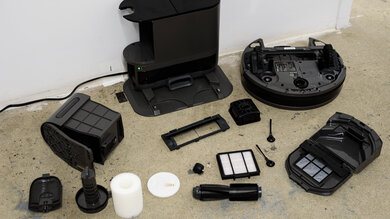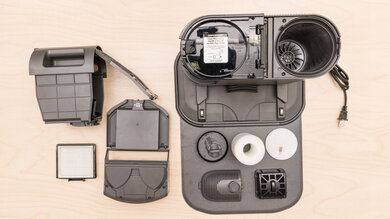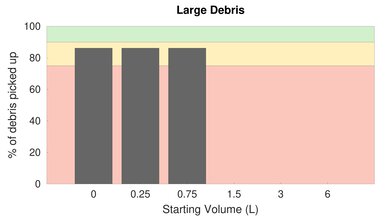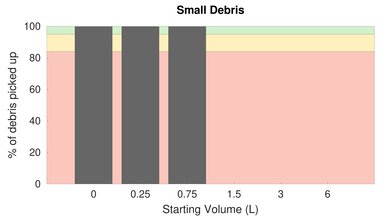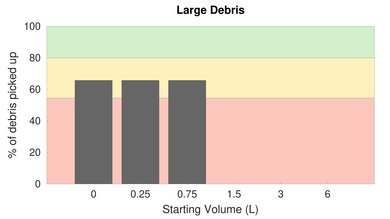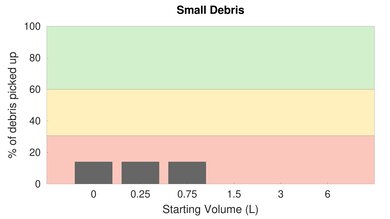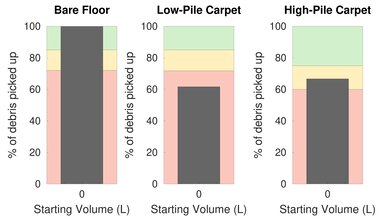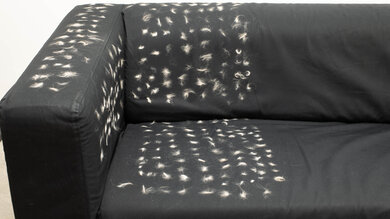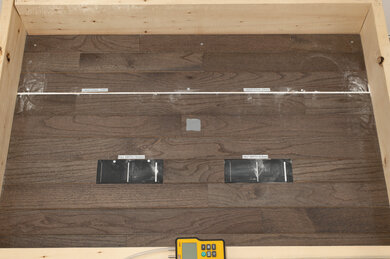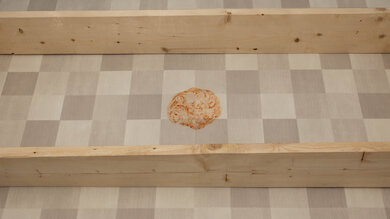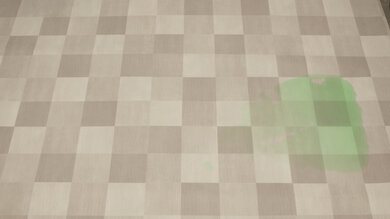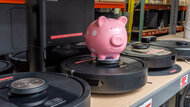The Shark EZ Robot Self-Empty is a mid-range robot vacuum that comes bundled with a self-emptying base station, letting it automatically dump debris from its internal dustbin into an external dirt compartment for easier maintenance. Compared to the pricier Shark AI Ultra Robot, which also has an automatic base station, it lacks a LIDAR mapping sensor, resulting in less precise navigation and a more limited set of automation capabilities. Otherwise, its debris-pickup performance is similar.
Our Verdict
The Shark EZ Robot vacuum is decent for bare floors. It clears pet hair and small debris without issue, though it struggles somewhat with bulky material. It feels well-built, has a long battery life, and offers a fairly wide range of automation features, including its self-emptying dustbin. Unfortunately, many parts need regular cleaning. Recurring costs are also high, with many components needing periodic replacement. Also, while it can do a good job of maneuvering itself, it generally won't climb over obstacles like power cables and may treat them as solid barriers rather than low obstacles.
-
Fantastic pet hair cleaning performance on bare floors.
-
Automatically empties dirt compartment into large external dustbin.
-
Long battery life.
-
High recurring costs.
-
Many parts need regular cleaning.
-
No mopping feature.
The Shark EZ Robot vacuum is mediocre for cleaning low-pile carpets. It'll take a couple of passes for this vacuum to clear away solid debris as well as pet hair from this surface type. While it feels sturdily built, it's demanding in regular maintenance requirements, with many parts needing regular cleaning. Recurring costs are also high since many components need periodic replacing, too.
-
Automatically empties dirt compartment into large external dustbin.
-
Long battery life.
-
Good build quality.
-
High recurring costs.
-
Many parts need regular cleaning.
-
Poor overall debris pickup on low-pile carpet.
The Shark EZ Robot Self-Empty is a passable choice for cleaning high-pile carpet. It doesn't have any trouble maneuvering on this surface type, though rug tassels can occasionally get caught in its brushroll. While it has a hard time with fine debris embedded in carpet fibers, it's fairly capable when dealing with larger debris and pet hair. It has a broad range of automation features, including its self-emptying function. However, many parts need regular cleaning or replacing, so recurring costs are high.
-
Automatically empties dirt compartment into large external dustbin.
-
Long battery life.
-
High recurring costs.
-
Many parts need regular cleaning.
The Shark EZ Robot Self-Empty isn't the best option for pet owners. It does a great job of handling pet hair on floors but struggles with hair on carpeted surfaces. It's demanding in regular maintenance and has high recurring costs too. It also lacks a HEPA filter to trap allergens as it cleans, and there's no mopping system to scrub away stains. Thankfully, its brushroll is removable, making it easier to remove any tangled hair wraps. It doesn't make much noise, which is good if your pet is sensitive to loud noises.
-
Fantastic pet hair cleaning performance on bare floors.
-
Removable brushroll.
-
High recurring costs.
-
Many parts need regular cleaning.
-
No HEPA filter.
-
No mopping feature.
The Shark EZ Robot Self-Empty is a robot vacuum and, therefore, isn't designed to clean stairs.
The Shark EZ Robot Self-Empty is a robot vacuum and, therefore, isn't designed to clean the inside of your car.
The Shark EZ Robot vacuum isn't designed for workshop cleaning.
- 7.1 Bare Floor
- 6.1 Low-Pile Carpet
- 6.2 High-Pile Carpet
- 4.8 Pets
- 5.8 Stairs
- 4.6 Cars
- 4.2 Workshop
Changelog
- Updated Sep 24, 2024: We've added a link to the Narwal Freo X Ultra in the 'Build Quality' section of the review to provide an alternative that feels more sturdily built.
- Updated Dec 14, 2023: Converted to Test Bench 0.7.
- Updated Oct 25, 2023: We've added a link to the Shark Matrix Robot in the 'Low-Pile Carpet Performance' section to provide an alternative with better debris pickup on this surface type.
- Updated Feb 21, 2023: We've changed the full product name to 'Shark EZ Robot Self-Empty' in order for the review to encompass all model variants. We've also added the RV910S, RV912S, and RV913S variants to the 'Differences Between Variants' section.
- Updated Feb 06, 2023: We've updated the text in the review to account for the new tests and scoring methodology in Vacuum Test Bench 0.5 and Vacuum Test Bench 0.6.
Check Price
Differences Between Sizes And Variants
There are a few different variants of the Shark EZ Robot Self-Empty, though there aren't really any major differences between them; RV models are older, whereas AV models are newer and have an additional floor sensor. We tested the AV911S, which is only available in one color variant: Gray. You can see its label here.
| Model Code | Color | Notes |
| AV911S | Gray | Refreshed model with extra floor sensor |
| RV910S | Black | |
| RV912S | Dark Gray | Canadian-market exclusive |
| RV913S | White |
Let us know if you come across another variant of this vacuum, and we'll update our review.
Compared To Other Robot Vacuums
The Shark EZ Robot Self-Empty is a fairly versatile robot vacuum. Like the i7+ variant of the iRobot Roomba i7, it has an external dustbin mounted to its docking station, so you don't need to empty the vacuum manually whenever it gets full. It differs in that its external base station doesn't use disposable dirtbags, meaning that final debris disposal isn't quite as hygienic. It delivers good performance on bare floors and does an impressive job cleaning high-pile carpets. However, it has demanding maintenance requirements and incurs high recurring costs, even by the standards of other robot vacuums.
If you're looking for alternatives, take a look at our list of recommendations of the best robot vacuums, the best robot vacuums for carpet, and the best robot vacuums for pet hair.
The Shark AI Ultra Robot is better than the Shark EZ Robot Self-Empty, though the two vacuums are similar in some ways. The AI Ultra has a LIDAR sensor for faster, more precise room mapping, though it can also register common household objects as obstacles to avoid. Performance on bare surfaces is pretty similar, though the AI Ultra has an easier time dealing with pet hair and clears more debris on low- and high-pile carpets.
The Shark EZ Robot Self-Empty is slightly better than the Shark IQ Robot. The EZ has an automatic dirt disposal feature, charges a lot faster, gets caught on rug tassels less frequently, and delivers better overall cleaning performance on low and high-pile carpets. Conversely, the IQ incurs fewer recurring costs, and is easier to maintain.
The Shark EZ Robot Self-Empty and the Shark AI Robot both have advantages, meaning one may suit you better depending on your own needs. The EZ has a much greater dirt compartment capacity because of its external dustbin and delivers superior performance on low- and high-pile carpets, especially when dealing with pet hair. Meanwhile, the AI incurs fewer recurring costs, has fewer parts that need regular cleaning, and maneuvers over obstructions like electrical cords with less difficulty. In addition, you can use its companion app to set up virtual boundary lines that the AI won't cross.
The Shark EZ Robot Self-Empty is better than the Shark IQ Robot AV992 Series. The EZ has an automatic dirt disposal function, charges slightly faster while offering similar overall battery life, and maneuvers over tasseled rugs with less difficulty. Meanwhile, the AV992 has fewer parts that need regular cleaning and incurs lower recurring costs.
The Shark EZ Robot Self-Empty and the Shark Matrix Robot are ultimately fairly similar overall performers, though the Matrix does offer a unique advantage in the form of its LIDAR mapping sensor, which allows for quicker and more precise mapping, even in the dark. With that being said, the EZ Robot offers more thorough room coverage, and its lack of a tall LIDAR sensor allows it to slip under some tables and chairs that the Matrix wouldn't be able to.
The Shark EZ Robot Self-Empty is better than the Shark ION Robot AV753 Series for most uses. The EZ delivers better performance on bare floors and carpets, maneuvers itself with less difficulty, and has a broader range of automation features. Its external dustbin also gives it a larger, more effective debris capacity. However, the ION has fewer parts that need periodic replacing or maintenance and has a longer maximum battery life, though it does take notably longer to recharge than the EZ.
The iRobot Roomba i7 is slightly better than the Shark EZ Robot Self-Empty. The iRobot feels better built, is easier to maintain, delivers slightly better performance on low-pile carpets, maneuvers itself more efficiently, and allows you to set up virtual boundary lines through its companion app. Its external dustbin uses disposable dirtbags that have a larger total capacity than the Shark's bagless base station, too. Meanwhile, the Shark incurs fewer recurring costs, clears more debris on bare floors and high-pile carpets, and has a considerably longer maximum battery life, though the iRobot does charge a lot faster.
The iRobot Roomba i3 and the Shark EZ Robot Self-Empty each have advantages, meaning one may suit you better than the other, depending on your needs. The iRobot has a larger external dustbin mounted to its base station, feels better built, has fewer parts that require periodic maintenance, maneuvers itself more effectively, and delivers superior performance on bare floors. It also charges much faster, though it doesn't last as long as the Shark on a single charge. The Shark also outperforms the iRobot on carpeted floors, especially with pet hair, and incurs fewer recurring costs.
The Shark EZ Robot Self-Empty is better for more use cases than the iRobot Roomba 694. The Shark has a self-emptying feature that lets it dump any accumulated debris from its internal dustbin into an external dirt compartment mounted on its charging station. The Shark does a better job maneuvering itself and clears more debris on carpeted floors. However, the iRobot feels better built, has fewer parts that need regular cleaning, and incurs lower recurring costs.
The Shark EZ Robot Self-Empty is better than the eufy RoboVac 11S. The Shark is better built, has a larger dirt capacity thanks to its large external dustbin, delivers superior performance on all surface types, and maneuvers itself more effectively. Conversely, the eufy is easier to maintain and incurs fewer recurring costs.
The yeedi vac station is better than the Shark EZ Robot Self-Empty. The yeedi feels better built, is less demanding in terms of maintenance, delivers a wider range of automation features, including virtual boundary markers, and is more maneuverable. Meanwhile, the Shark clears debris more effectively on low-pile carpets and takes less time to recharge, though its maximum battery life is slightly shorter. The yeedi's self-emptying base station also uses disposable dirtbags that have a much larger capacity.
The Shark EZ Robot Self-Empty and the iRobot Roomba i1 each have their strengths, meaning one might suit you better than the other, depending on your needs. The Shark incurs lower ownership costs, as its self-emptying base station doesn't use disposable dirtbags. The Shark also struggles less with bulky debris. However, the iRobot's self-emptying base station has a greater debris capacity. The iRobot is also easier to maintain, takes much less time to recharge, and has a more intuitive companion app.
The Shark Matrix Plus is better than the Shark EZ Robot Self-Empty. The Matrix Plus features a LIDAR navigation sensor that allows for quicker, more precise mapping and supports a wider array of automation features, including virtual no-go zones and room labeling. The Matrix Plus' external dustbin also has a slightly greater capacity.
Test Results
The build quality is good. It's similar in design to other Shark robot vacuums, like the Shark AI Robot, with a matte-finish hard plastic body and twin drive wheels with rubber treads. Conversely, its hard plastic dirt compartment feels a little flimsy. It's easy to assemble out of the box, requiring only that you snap its two side brushes into place and place the self-emptying dock station on the included mat. The manufacturer recommends only placing the mat on carpets, as it can slip around on bare floors. Check out the Narwal Freo X Ultra if you want something that feels more robust.
This vacuum is quite hard to maintain as it has many parts that require regular maintenance. Luckily, most parts are easy to access.
- Dustbin: You can remove the dustbin by simply pressing the two release buttons at the back of the part and then lifting it free. The vacuum automatically dumps accumulated debris into the external dirt bin on the charging dock, but you can empty it yourself if you feel that it's necessary.
- Dustbin filter: Cleaning the internal dustbin filter and lint screen is a bit of a hassle, as they're both held in place by Philips-head screws. You should remove any stuck-on debris by hand regularly, but make sure not to wash it under water.
- Base station dustbin: The external dustbin releases from the base station pretty easily. Another button on the side opens a compartment door, so you can dump out any accumulated debris. According to the manufacturer, it can hold up to roughly 15 days' worth of collected debris.
- Base station dust bin pre-motor filters: Unlike the internal filters, you can simply lift the base station filters directly from their housing. You should clean them using only cold water once a month. Make sure to let them dry for at least 24 hours before putting it back in its place.
- Base station post-motor filter: You can find the post-motor filter in the base station behind a filter door on the base station. You should rinse it with cold water once a year. Leave it to air dry completely before reinstalling it.
- Brushroll: You can access the brushroll by removing the brushroll cover, which is fairly easy and doesn't require any tools. That said, the brushroll is somewhat tangle-prone. You can remove any stuck-on debris or tangled hair by hand whenever necessary.
- Side brushes: You can simply pull the two side brushes from their sockets with no need to unscrew them. Check for any accumulated debris once a week and clean them as necessary, either by hand or with a dry cloth, as they tend to collect quite a bit of debris.
- Drive wheels: You should clear the drive wheels and their housings of any accumulated debris whenever necessary. Make sure to rotate the wheels to ensure full coverage.
- Front wheel: You can simply pull the front wheel from its housing, but you may need another tool to get enough leverage. Remove any accumulated dust, dirt, or hair from the wheel and the socket when necessary.
- Sensors and charging pads: You should dust the sensors and charging pads whenever you notice a buildup of debris.
This vacuum incurs high recurring costs.
- Pre-motor filter: There isn't a specified replacement time for this filter. That said, you can buy a replacement from Shark's website.
- Base station dust bin pre-motor filters: You should replace this filter every two and a half years. You can buy a replacement here.
- Base station post-motor filter: The base station's post-motor filter has an estimated service life of three years.
- Brushroll: You should replace the brushroll every six to 12 months, depending on your usage. You can buy a replacement here.
- Side brushes: You should replace the side brushes if bent or damaged.
Shark also offers a 'Replacement Bundle', which includes:
- 1x Vacuum filter
- 1x Brushroll
- 4x Side brushes
This vacuum is very easy to store. The vacuum itself isn't very big, and its external dustbin is much shorter than the i7 variant of the iRobot Roomba i7.
The combined capacity of this vacuum's internal dustbin and base station dirt compartment is decently large, though it has a smaller capacity than the self-emptying base station that's compatible with the iRobot Roomba i1, which uses a higher-capacity disposable dirtbag. The external dust bin has a clear plastic window that gives you a rough estimate of how full it is.
- Shark EZ Robot Self-Empty AV911S
- Robot vacuum body
- Internal dust bin
- Pre-motor filter
- 2x Side brushes
- Brushroll
- Brushroll door
- Owner's guide
- Base Station
- Self Empty Station /Charging station
- Base station dust bin
- Base station dust bin pre-motor filters (felt and foam)
- Base station dust bin post-motor filter and cover
- Base station mat for use on carpets
This vacuum's range is limited only by its remaining battery life. That said, it can't climb or descend stairs.
This vacuum is impressively portable. It's slightly lighter than alternatives like the iRobot Roomba i7, though it lacks a carrying handle to make it easier to pick up and lift from room to room.
The battery performance is superb. In its high-power 'Max' power mode, it supplies roughly 70 minutes of cleaning time. You can stretch it to over 140 minutes if it's run in 'Eco' mode. Unfortunately, the vacuum doesn't remember the power setting it was set to on previous cleaning sessions, so you have to make that adjustment manually every time. Like the Shark AI Robot, a set of indicator lights on the top surface of the vacuum give you a rough estimate of how much charge is remaining.
The Shark EZ Robot Self-Empty has a couple of quality-of-life features. There are three suction power modes: 'Normal', which is the default mode that you can only change once the vacuum is up and running, the more energy-efficient 'Eco' mode, and the high-power 'Max' mode. Still, unlike the Shark AI Ultra Robot, it doesn't have a LIDAR mapping system, which would help navigate in darker environments.
This vacuum has a pair of side brushes that move debris from the outside edges of the vacuum into the path of its main brushroll.
Performance on bare floors is excellent. It clears away small debris like rice without any issue, but it might take another go-around to clear away bulkier debris like cereal.
Note: Since this vacuum automatically empties its internal dirt compartment when docked after completing its job, it doesn't lose suction performance. All testing was completed when the dirt compartment was empty, with the data for the 0.25L and 0.75L tests being copied from the 0L test.
Performance on low-pile carpet is poor. It clears most larger debris like sand but has a hard time cleaning finer debris like baking soda from this surface type. Check out the Shark Matrix Robot if you're looking for a robot vacuum that performs better on this surface type.
Note: Since this vacuum automatically empties its internal dirt compartment when docked after completing its job, it doesn't lose suction performance. All testing was completed when the dirt compartment was empty, with the data for the 0.25L and 0.75L tests being copied from the 0L test.
Performance on high-pile carpet is okay. It does a great job when it comes to clearing larger debris like sand, but similar to its performance on low-pile carpet, this vacuum struggles with finer debris.
Note: Since this vacuum automatically empties its internal dirt compartment when docked after completing its job, it doesn't lose suction performance. All testing was completed when the dirt compartment was empty, with the data for the 0.25L and 0.75L tests being copied from the 0L test.
Pet hair cleaning performance is great but heavily conditional on the floor type in your home. It doesn't struggle with pet hair on hard surfaces like vinyl or hardwood and is fairly effective on high-pile carpet, but it struggles with pet hair ground into low-pile carpet fibers.
Like most robot vacuums, the Shark EZ Robot Vacuum has poor suction performance at its floorhead. The suction inlet is positioned too high above the ground to generate a tight seal on bare surfaces.
This vacuum is remarkably quiet. It makes even less noise than alternatives like the Wyze Robot Vacuum, and you won't have too much trouble hearing what people nearby are saying even with the vacuum running in the same room in its 'Max' power setting.
This vacuum has good maneuverability. It cleans in an efficient, organized pattern and can even return to areas that require more cleaning. It's also small enough to clean under most couches and tables. It can clean most rugs, though tassels can get caught in its brushroll on some rare occasions. Unfortunately, it struggles with low-lying obstructions like electrical cords, which the vacuum may identify as obstacles to avoid.
Air filtration performance is middling overall. Its post-motor filter isn't HEPA-rated, and a small number of particles can escape from its exhaust. Check out the Roborock S5 Max if you want a mid-range robot vacuum that does a better job of sealing in allergens.
This vacuum does a terrible job of dealing with debris in cracks and crevices. Not only does it lack the necessary suction to draw debris from deep crevices, but its twin side brushes also tend to grab fine debris from shallower crevices and flings it outwards rather than direct it towards the brushroll.
This vacuum doesn't make any impact on stains. Unlike the Roborock S7, it doesn't have a mopping feature that would allow it to scrub away dried-on dirt and debris.
The Shark EZ Robot Self-Empty has excellent physical automation features. One of its most notable features is its self-emptying capability, which reduces hands-on maintenance requirements. It can also be connected to Alexa or Google Home devices if you'd prefer to use voice commands to control the vacuum. Unfortunately, there aren't any physical boundary strips included with the vacuum that would keep it out of certain areas. The two control buttons on top of the vacuum are somewhat limited in capability, as they only allow you to start and stop a cleaning session or send the vacuum back to its dock.
The SharkClean app is decent overall. It's fairly feature-packed but not especially intuitive to use, and it's also prone to freezing. You can use the app to change the vacuum's suction power mode, command it to clean or return to its dock, schedule cleaning sessions, check the cleaning history and charge status, update the vacuum's firmware, or enable push notifications. You'll also need a 2.4GHz Wi-Fi connection to control the vacuum via the app. Unlike the Shark AI Robot, you can't set up virtual no-go zones through the companion app.



